
views
Learning the Rules of Indoor Soccer
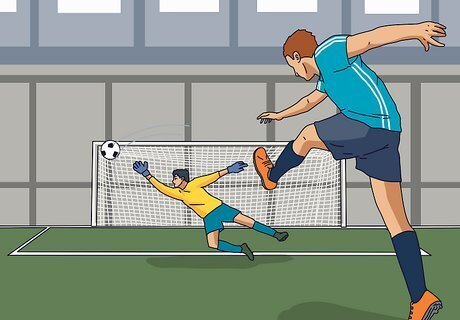
Understand the objective of the game. Soccer is a relatively simple game in that the objective is simply to get the ball into the opposite team’s goal box. Getting the ball into the goal box scores the team one point and is known as a goal. There are two teams in a soccer game and they face each other on a field, with the goal boxes placed at opposite ends of the field. Therefore, the players must compete to get possession of the ball in the opposite team’s territory and eventually shoot it into the goal to score a point. A typical game involves one team dribbling (running with the ball at their feet) the ball up the field and passing it amongst each other to get it close enough for one player to shoot a goal. The opposite team also tries to take possession throughout so oftentimes the ball moves throughout both sides of the field.
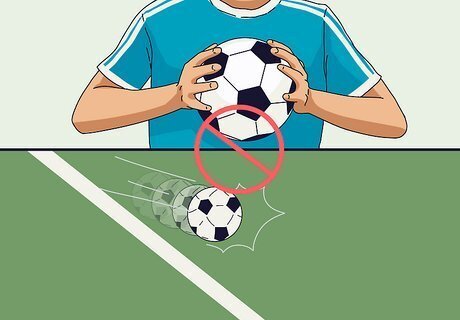
Know the primary rules. Perhaps the most important rule of soccer is that players (with the exception of the goalkeeper) cannot touch the ball with their hands or arms while the ball is in play. Players also cannot tackle, push, hit, or otherwise intentionally hurt or sabotage their opponents. If the ball goes out of the field, the team that caused the ball to go out loses possession and the other team is allowed to kick or throw the ball back into the game. However, indoor soccer differs in this respect as, depending on the venue, it is often impossible for the ball to go out of the field as it simply bounces back in off the walls.
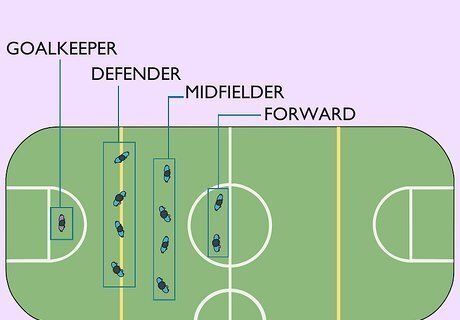
Know the different positions. Each soccer team is roughly divided into defense and offense, with different players having specific objectives, such as shooting the ball or defending. With indoor soccer, there is less differentiation between the players so, though they are assigned the following positions, they have more flexibility and move around the field more freely than in outdoor soccer. Two people are assigned in the defense position and help the goalie prevent the opposing team from scoring a goal. Two other players start by standing a few feet in front of the defenders and they are known as forwards. They are on the offensive, meaning they work to play the ball into the opposite side of the field to score a goal. One person plays midfielder and begins at the very front and center of their team’s side of the field. This person plays both forward and defense as needed. The same rules apply to each player regardless of their position with the only exception being the goalkeeper (also known as a goalie). The goalie is the last line of defense against the opposing team and is allowed to use their hands to catch or block the ball from going into the goal box.
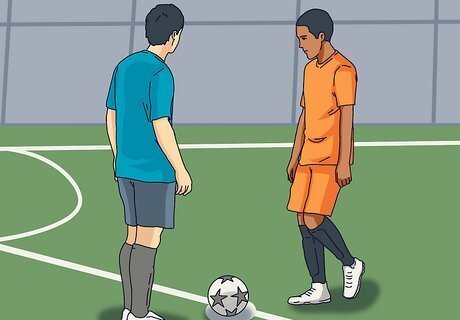
Understand how a game begins and ends. A soccer game begins with a kickoff and ends after a set period of time, with the team having the most goals by the end designated as the winner. A professional soccer match is 90 minutes long, but the length of time can vary depending on the type, whether either team has scored or not, and so on. A kickoff is when both teams take their positions on their halves of the field with the ball at the center of the field and two players on either side. Once the referee calls the game into play, the two players try to take possession of the ball first. A kickoff begins the game and also restarts it after a goal has been scored.
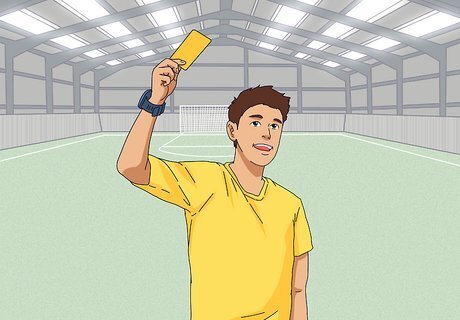
Understand the role of the referee. The referee is responsible for overseeing the game and making sure that the players abide by the rules. The referee also signals the beginning and end of the game and gives the ultimate call on who wins. Referees can give out different cards when someone has broken the rules of the game, which is known as a “foul.” When the referee sees a player fouling (by pushing another player for example), they can give the player a yellow card which indicates a warning. If a player gets two yellow cards, they are ejected from the game and the team must play on without a substitute player. If a referee decides a player has committed a number of fouls or one that indicates extremely poor sportsmanship, he can give a player a red card which automatically ejects them from the game.
Differentiating Indoor and Outdoor Soccer Rules
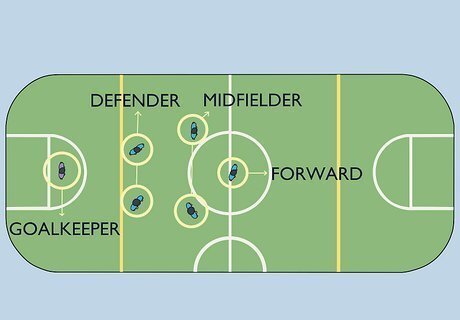
Know the different positions. Indoor and outdoor soccer varies in some crucial ways (mostly due to the smaller size of the field for indoor soccer), including the different positions players can be in. With indoor soccer, there are only 6 players, including the goalkeeper, on each team. The players that would normally be considered defense or forward have more flexibility in their roles and can play both offensive and defensive roles. Basically, all players (including the goalie) have more freedom to move around in the arena and are less bound to one specific function in the game.

Learn indoor soccer-specific rules. Because indoor soccer is played in a smaller, enclosed area, there are certain rules that differ from outdoor soccer. Many of these rules are similar to other arena sports. Players can be substituted at any point during the game. For example, with indoor soccer the game continues without any penalties or stoppage if the ball hits the walls enclosing the field. The game simply continues with each player rushing to take possession of the ball. This practice is known as “play off the walls.” Only if the ball goes over the walls and out of the field entirely is there a stoppage and the team that didn’t strike out the ball is allowed to throw or punt it back in (as in outdoor soccer). However, some indoor arenas have walls that completely enclose the area, in which case it is impossible for the ball to go out of bounds.
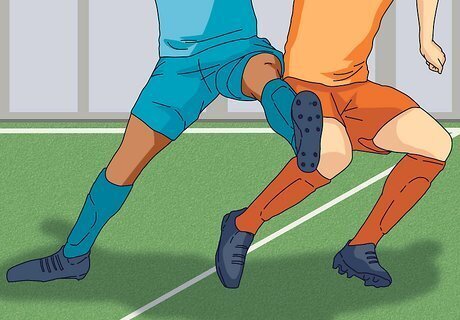
Know which rules are the same as in outdoor soccer. Though there are many differences between indoor and outdoor soccer, the overall objective and methods of playing are more similar than they are different. Therefore, knowing the similarities will help you pick up the mechanics of indoor soccer more quickly. For example, standard rules of no contact apply in indoor soccer. You cannot hit, intentionally kick, or otherwise physically obstruct another player during the game. The method of scoring a goal is also the same. To score a goal, a player must kick the ball into the opposing team’s goal box, passing over the goal line, between the posts, and under the crossbar. If the referee calls a foul for breaking a rule (such as using your hands), the same rule of a free kick on the part of the opposite team applies.
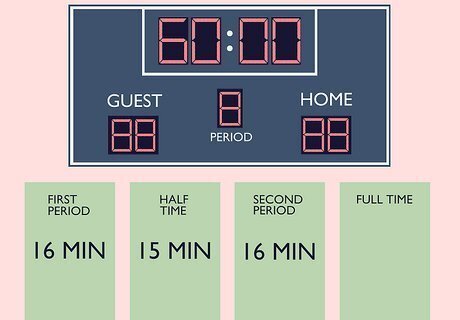
Decide on the duration of the match. Professional indoor soccer matches are played for sixty minutes at a time, in quarter increments with three minutes of rest between each quarter and a fifteen minute break at halftime. However, in casual games and nonprofessional leagues, the amount of play time and breaks differ so either find out beforehand or, if you are creating your own game with friends, decide ahead of time how to divvy up the playing time. If a professional indoor soccer game is tied, there can be two extra fifteen minute halves of playtime with the agreement that the team that scores a goal first wins the game.
Adapting to Playing Indoors

Get the right gear. Just as with outdoor soccer, you will need a pair of shin guards, long socks, and shoes. However, instead of outdoor soccer cleats, you will need a pair of indoor soccer shoes, which differ by having flat outsoles. Lightweight sneakers or running shoes can also work in a pinch, but you will not have the same speed and ease of movement.

Practice playing with the ball indoors. If you are an outdoor soccer player adapting to playing indoors, spend some time getting used to juggling the ball indoors. Whether you are playing on astroturf or a hard, smooth surface, the ball will have far less traction and you will likely have to move your feet more quickly to control the ball across the field.
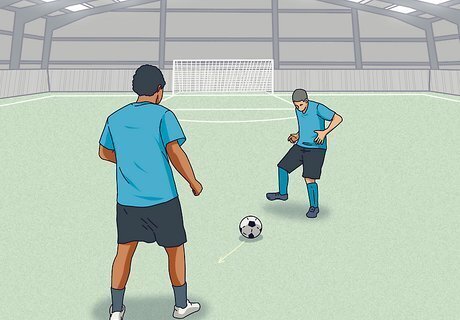
Play fast. Indoor soccer is faster-paced than outdoor soccer, which will keep you in shape and also sharpen your playing skills but the rapid pace will take some getting used to. Focus on making quick passes and small, controlled movements with your feet until playing faster comes naturally. Be more verbally communicative. Because the game is so fast and you are in an enclosed space, expect to talk to your teammates more. Oftentimes you may deliver a pass only to find yourself in a great spot to receive the ball again. In these moments, it’s best to yell “pass” or otherwise let your teammates know where you are positioned.
Becoming a Great Indoor Player
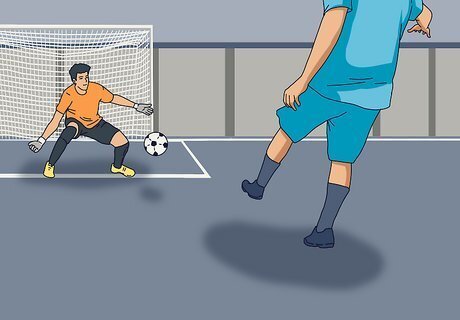
Practice shooting accurately. In indoor soccer arenas, the goals are generally recessed into the walls and are also smaller. Because of this, it’s important to shoot as accurately as possible. Practice shooting on your own or with a buddy. Try different shots, such as always aiming for just below the crossbar (requiring the goalie to jump in order to block it).
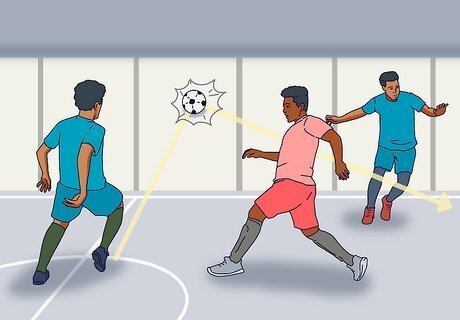
Utilize the walls to your advantage. Perhaps the biggest difference between indoor and outdoor soccer is that you can play off the wall. Professional indoor soccer players will use the walls to their advantage by kicking the ball against the wall to get past an advancing opponent. Practice intentionally kicking the ball against the wall to either pass it to someone or to get past the opposite team. Be patient with yourself however, as this is a very complex skill that will take lots of practice to develop over time.

Get fit. Indoor soccer is much more physically challenging than outdoor, as the plays are quicker and each player is engaged more or less constantly throughout the game. Running (including sprints), lifting weights, and doing other exercises that build your muscles and also increase your speed will help you improve as an indoor soccer player.
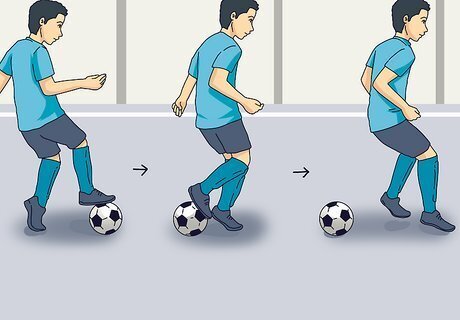
Learn small moves to trick the opposite team. Small movements are vital in indoor soccer as you want to constantly have the upperhand by faking out the other team. Having a set of tricks up your sleeve will make you a better soccer player and give your team an edge. For example, when shooting the ball, try doing a toe-kick. Since distance isn’t as much of a factor in shooting, shooting the ball using your toes will cause the ball to suddenly jump upwards, which can fool the goalie into not blocking it in time. Instead of passing the ball directly to where a team player is standing, pass the ball into the space where the player is most likely to get possession. The player will be able to see the ball’s course and get likely get there in time to take possession before the opposing team can steal the ball. Another great skill is the Drag Back. To do a Drag Back, roll the ball back under your foot (as opposed to dribbling it forward) and bring it closer to yourself. By doing this, you are protecting possession and also giving yourself more opportunities to either move the ball in a different direction or do a quick pass.











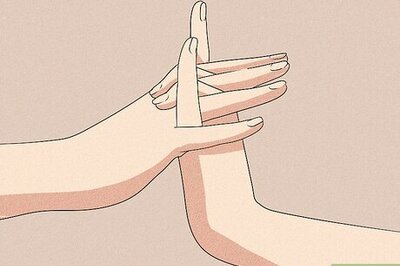




Comments
0 comment